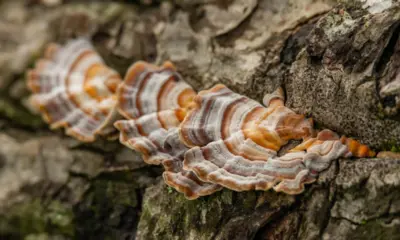Science
Edible Turkey Tail Mushroom Offers Innovative Eco-Friendly Coating

Research conducted by the University of Maine has revealed a promising alternative to single-use plastic food wrap and synthetic paper cup coatings. The study focuses on utilizing turkey tail fungus, scientifically known as Trametes versicolor, combined with wood fibers to create a sustainable, waterproof coating.
The researchers aimed to develop an environmentally safe coating resistant to water, oil, and grease while ensuring it remained food-safe. They achieved this by experimenting with the mycelium, a root-like structure of the fungus that intertwines within the wood it grows on. This mycelium forms a dense network of featherlike strands that exhibit waterproof properties.
Innovative Coating Process
To create the coating, the researchers combined the mycelium with nanofibrils, which are tiny wood cellulose fibers commonly used in paper-making. This mixture was then applied in thin layers to various surfaces, including two types of paper, denim, polyester felt, and birch wood veneer. The coated materials were dried in an oven, resulting in a waterproof barrier comparable to the thickness of paint after just three days of fungal growth.
According to Assoc. Prof. Caitlin Howell, the corresponding author of the study, “Our hope is that by providing more ways to potentially reduce our reliance on single-use plastics, we can help lessen the waste that ends up in landfills and the ocean; nature offers elegant, sustainable solutions to help us get there.”
Tests conducted on the coated materials showed significant effectiveness. Water droplets placed on the treated surfaces beaded up into small spheres, while those on untreated surfaces spread out or were absorbed. The fungal coating also demonstrated its ability to repel other liquids, including fuel n-heptane, the solvent toluene, and castor oil, indicating its potential as a versatile barrier.
Broader Implications for Mycelium Technology
This innovative approach is part of a growing trend in utilizing mycelium-based products across various industries. In the construction sector, for instance, researchers at Nanyang Technological University in Singapore have developed tiles made from oyster mushrooms and bamboo scraps. These tiles, resembling elephant skin due to their bumpy surface, are designed to improve energy efficiency in buildings by keeping them cool in warm months.
Another example includes mycocrete, a type of concrete made from mycelium and grains, currently in development at Newcastle University in Britain. Such advancements highlight the versatility of mycelium beyond food-related applications, paving the way for sustainable building materials.
The findings from the University of Maine’s study were recently published in the journal Langmuir, adding to the growing body of research that emphasizes the importance of finding eco-friendly solutions to combat plastic waste. As more innovative applications for mycelium emerge, the potential for these natural materials to replace synthetic options across various sectors continues to expand.
-

 Technology5 months ago
Technology5 months agoDiscover the Top 10 Calorie Counting Apps of 2025
-

 Health3 months ago
Health3 months agoBella Hadid Shares Health Update After Treatment for Lyme Disease
-

 Health3 months ago
Health3 months agoErin Bates Shares Recovery Update Following Sepsis Complications
-

 Technology4 months ago
Technology4 months agoDiscover How to Reverse Image Search Using ChatGPT Effortlessly
-

 Technology3 months ago
Technology3 months agoElectric Moto Influencer Surronster Arrested in Tijuana
-

 Technology1 month ago
Technology1 month agoDiscover 2025’s Top GPUs for Exceptional 4K Gaming Performance
-

 Technology6 days ago
Technology6 days agoOpenAI to Implement Age Verification for ChatGPT by December 2025
-

 Technology5 months ago
Technology5 months agoMeta Initiates $60B AI Data Center Expansion, Starting in Ohio
-

 Technology5 months ago
Technology5 months agoRecovering a Suspended TikTok Account: A Step-by-Step Guide
-

 Health5 months ago
Health5 months agoTested: Rab Firewall Mountain Jacket Survives Harsh Conditions
-

 Health3 months ago
Health3 months agoAnalysts Project Stronger Growth for Apple’s iPhone 17 Lineup
-

 Lifestyle5 months ago
Lifestyle5 months agoBelton Family Reunites After Daughter Survives Hill Country Floods













